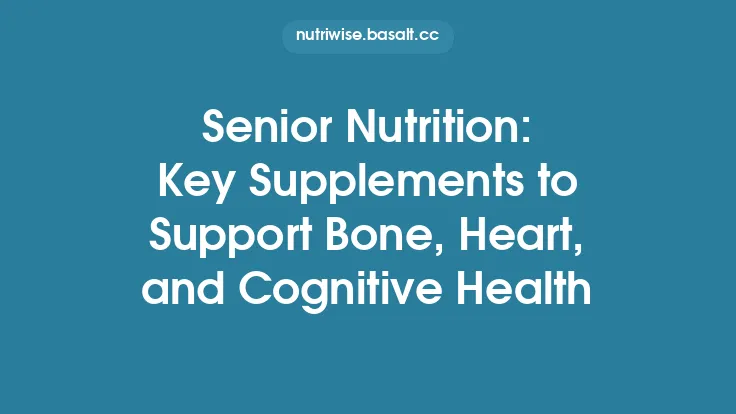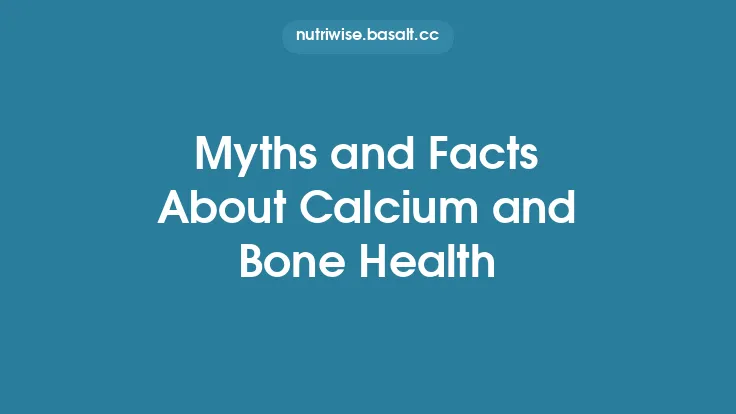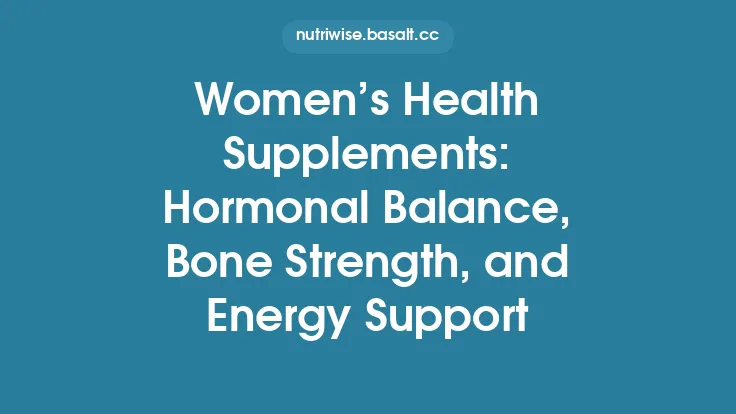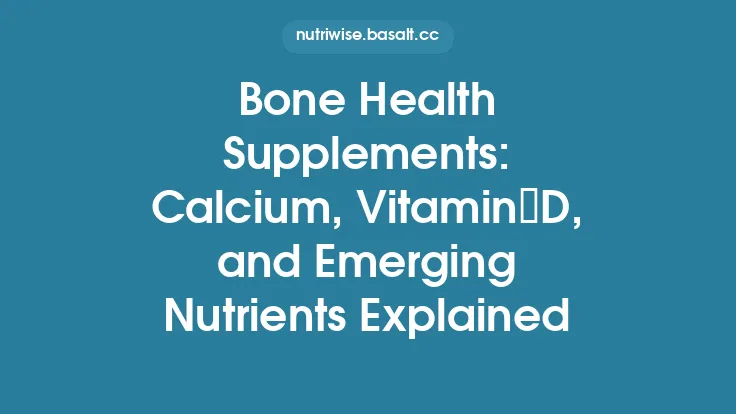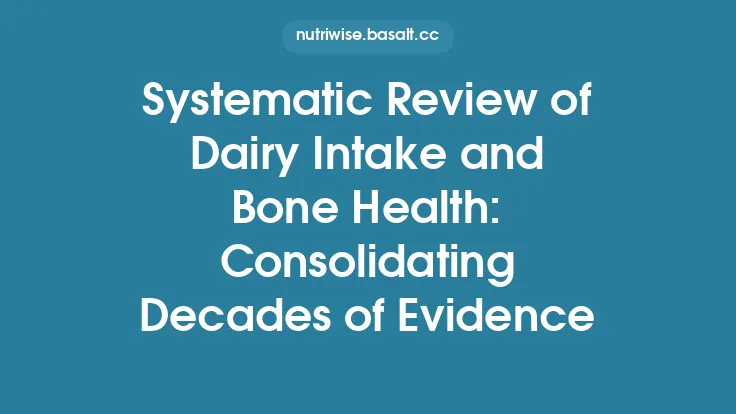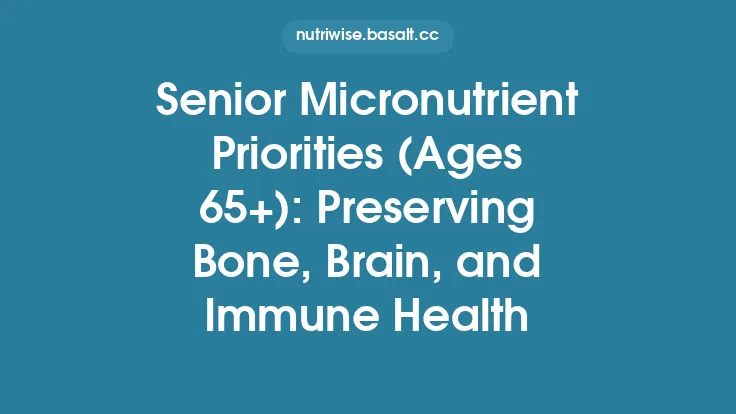Post‑menopause brings a cascade of hormonal shifts that profoundly affect both skeletal integrity and cardiovascular function. Estrogen, which once helped maintain bone density and supported favorable lipid profiles, declines sharply, leaving many women vulnerable to osteoporosis and heart disease. While a balanced diet, regular physical activity, and routine medical care form the foundation of health maintenance, targeted supplementation can fill critical nutrient gaps, mitigate risk, and support optimal function of bone and heart tissues. Below is a comprehensive, evidence‑based guide to the supplements most relevant for post‑menopausal women seeking to protect their bones and cardiovascular system.
Understanding the Physiological Changes After Menopause
- Bone Remodeling: Estrogen deficiency accelerates osteoclast activity (bone resorption) while blunting osteoblast function (bone formation). This imbalance leads to a net loss of bone mineral density (BMD), especially in the lumbar spine and hip, increasing fracture risk.
- Lipid Metabolism: Estrogen also modulates hepatic lipoprotein synthesis. Its loss often results in higher LDL‑C, lower HDL‑C, and increased triglycerides, contributing to atherosclerotic plaque development.
- Inflammation & Oxidative Stress: Both bone loss and atherogenesis are fueled by low‑grade chronic inflammation and oxidative stress, which become more pronounced after menopause.
- Calcium Homeostasis: Reduced intestinal calcium absorption and altered vitamin D metabolism further compromise skeletal health.
Understanding these mechanisms helps prioritize supplements that directly address the underlying pathways—bone turnover, lipid regulation, inflammation, and oxidative balance.
Core Supplements for Bone Health
| Supplement | Primary Role | Typical Effective Dose* | Key Supporting Evidence |
|---|---|---|---|
| Calcium (as calcium citrate or carbonate) | Provides the mineral substrate for bone mineralization | 1,000–1,200 mg elemental calcium per day (split doses) | Meta‑analyses show modest BMD preservation when combined with vitamin D |
| Vitamin D₃ (cholecalciferol) | Enhances calcium absorption; modulates bone remodeling hormones | 800–2,000 IU daily (serum 25(OH)D target 30–50 ng/mL) | RCTs demonstrate reduced fracture risk with adequate serum levels |
| Vitamin K₂ (MK‑7) | Activates osteocalcin, directing calcium to bone matrix | 100–200 µg daily | Observational studies link higher intake to higher BMD and lower fracture rates |
| Magnesium (as magnesium glycinate or citrate) | Cofactor for vitamin D activation; influences bone crystal formation | 300–400 mg elemental magnesium daily | Low magnesium status correlates with reduced BMD |
| Boron | Supports calcium and magnesium metabolism; may reduce bone resorption | 1–3 mg daily | Small RCTs show increased BMD when added to calcium/vitamin D |
| Collagen Peptides (hydrolyzed type I) | Supplies amino acids for bone matrix synthesis | 5–10 g daily | Trials report modest improvements in BMD and joint health |
\*Doses reflect ranges commonly used in clinical trials; individual needs may vary based on diet, absorption, and medical conditions.
Core Supplements for Cardiovascular Health
| Supplement | Primary Role | Typical Effective Dose* | Key Supporting Evidence |
|---|---|---|---|
| Omega‑3 Fatty Acids (EPA/DHA) | Improves lipid profile, reduces triglycerides, anti‑inflammatory | 1,000–2,000 mg EPA + DHA combined daily | Large RCTs (e.g., REDUCE‑IT) show reduced major cardiovascular events |
| Coenzyme Q10 (Ubiquinol) | Antioxidant; supports endothelial function and myocardial energy | 100–200 mg daily | Meta‑analysis indicates modest blood pressure reduction and improved arterial stiffness |
| Plant Sterols/Stanols | Compete with cholesterol absorption, lowering LDL‑C | 2 g daily | FDA‑approved claim for LDL‑C reduction |
| Magnesium | Vasodilatory; improves blood pressure and arrhythmia risk | 300–400 mg daily (as above) | Consistent inverse relationship with hypertension |
| Polyphenols (e.g., Resveratrol, Curcumin) | Anti‑inflammatory, improves endothelial nitric oxide production | Resveratrol 150–300 mg; Curcumin 500–1,000 mg with piperine | Small RCTs show improved flow‑mediated dilation |
| Vitamin B12 & Folate | Homocysteine metabolism; high homocysteine linked to atherosclerosis | B12 500–1,000 µg; Folate 400–800 µg daily | Trials demonstrate modest homocysteine reduction, though impact on events remains uncertain |
Supplements That Bridge Bone and Heart Benefits
Certain nutrients exert dual actions on skeletal and cardiovascular systems, making them especially valuable for post‑menopausal women:
- Vitamin K₂ (MK‑7) – Beyond osteocalcin activation, K₂ inhibits vascular calcification by activating matrix Gla‑protein, a potent inhibitor of calcium deposition in arteries.
- Magnesium – Supports bone mineral density and helps maintain normal blood pressure, arrhythmia prevention, and endothelial health.
- Omega‑3 Fatty Acids – Anti‑inflammatory effects reduce cytokine‑mediated bone resorption while also improving lipid profiles.
- Vitamin D – Adequate levels are associated with lower arterial stiffness and reduced risk of hypertension, in addition to bone health.
Incorporating these “bridge” nutrients can simplify supplement regimens while maximizing systemic benefits.
Evidence‑Based Dosage Guidelines and Timing
- Split Calcium Doses: Calcium is best absorbed in 500‑mg increments; taking it with meals improves absorption and reduces kidney stone risk.
- Vitamin D with Fat: Since it is fat‑soluble, ingest vitamin D alongside a meal containing healthy fats (e.g., avocado, nuts) to enhance bioavailability.
- Omega‑3 with Food: Consuming EPA/DHA with a meal containing fat improves plasma EPA/DHA levels and reduces gastrointestinal upset.
- Magnesium at Night: Many find magnesium (especially glycinate) calming; taking it before bedtime can aid sleep and muscle relaxation.
- Avoid High‑Dose Calcium with Iron or Zinc: Calcium can interfere with the absorption of these minerals; separate dosing by at least 2 hours.
Safety Considerations and Potential Interactions
| Concern | Details | Management |
|---|---|---|
| Hypercalcemia | Excess calcium, especially with high vitamin D, can lead to kidney stones or vascular calcification. | Monitor serum calcium and 25(OH)D annually; stay within recommended doses. |
| Vitamin K Antagonist Therapy | Women on warfarin or other vitamin K antagonists must keep K₂ intake consistent to avoid INR fluctuations. | Discuss with prescribing physician; consider a stable, low‑dose K₂ regimen. |
| Bleeding Risk with Omega‑3 | High EPA/DHA may modestly increase bleeding time, especially with anticoagulants. | Use ≤2 g EPA + DHA daily; monitor coagulation parameters if on warfarin or DOACs. |
| Drug‑Nutrient Interactions | Certain bisphosphonates (e.g., alendronate) require an empty stomach; calcium can impair absorption. | Separate bisphosphonate and calcium intake by at least 30 minutes. |
| Renal Impairment | Reduced kidney function limits magnesium and vitamin D clearance. | Adjust doses; obtain renal labs before initiating high‑dose regimens. |
| Allergies & Sensitivities | Some formulations contain soy, gluten, or dairy derivatives. | Choose hypoallergenic, certified‑free products when needed. |
Always encourage readers to consult a healthcare professional—particularly a physician or registered dietitian—before initiating new supplements, especially if they have chronic conditions or take prescription medications.
Integrating Supplements with Lifestyle Strategies
- Weight‑Bearing Exercise: Resistance training, brisk walking, or dancing stimulates osteoblast activity and improves lipid metabolism.
- Adequate Protein: 1.0–1.2 g/kg body weight per day supports bone matrix formation and preserves lean muscle mass, which indirectly benefits cardiovascular health.
- Balanced Diet: Emphasize leafy greens (vitamin K), fatty fish (omega‑3), fortified dairy or plant milks (calcium, vitamin D), nuts and seeds (magnesium), and whole grains (B‑vitamins).
- Stress Management: Chronic cortisol elevation can increase bone resorption and raise blood pressure; mindfulness, yoga, or moderate aerobic activity can mitigate these effects.
- Sleep Hygiene: 7–9 hours of quality sleep supports hormonal regulation, including growth hormone, which influences bone remodeling.
Supplements should complement—not replace—these foundational habits.
Monitoring Progress and When to Seek Professional Guidance
- Bone Health: Baseline dual‑energy X‑ray absorptiometry (DXA) scan, followed by repeat every 1–2 years. Track serum calcium, 25(OH)D, and PTH levels annually.
- Cardiovascular Markers: Lipid panel (LDL‑C, HDL‑C, triglycerides) every 6–12 months; blood pressure checks at each primary‑care visit; high‑sensitivity C‑reactive protein (hs‑CRP) if inflammation is a concern.
- Safety Labs: Serum magnesium, renal function (creatinine, eGFR), and liver enzymes if using high‑dose fat‑soluble vitamins.
- Red Flags: New onset chest pain, unexplained bruising, persistent gastrointestinal symptoms, or sudden changes in urinary calcium excretion warrant immediate medical evaluation.
Regular follow‑up enables dose adjustments, early detection of adverse effects, and reinforcement of adherence.
Frequently Asked Questions
Q: Can I get all these nutrients from food alone?
A: A well‑planned diet can meet many needs, but post‑menopausal physiological changes often increase requirements for vitamin D, calcium, and omega‑3s beyond typical dietary intake. Targeted supplementation helps bridge the gap.
Q: Is calcium carbonate as effective as calcium citrate?
A: Calcium citrate is more readily absorbed, especially in individuals with reduced stomach acid (common after age 50). If you tolerate carbonate and take it with meals, it remains a viable, cost‑effective option.
Q: How long does it take to see benefits?
A: Bone density changes are gradual; measurable improvements often appear after 12–24 months of consistent supplementation combined with exercise. Cardiovascular markers (e.g., triglycerides) may improve within 8–12 weeks.
Q: Should I take a “menopause” multivitamin?
A: Multivitamins can provide baseline nutrients, but they may not contain therapeutic doses of key bone‑heart nutrients (e.g., 1,000 mg calcium, 1,000 IU vitamin D, 100 µg vitamin K₂). Tailoring individual supplements ensures adequate dosing.
Q: Are there natural alternatives to synthetic vitamin K₂?
A: Fermented foods such as natto, certain cheeses, and sauerkraut contain MK‑7, but achieving therapeutic doses through diet alone can be challenging. Supplementation offers a reliable, standardized source.
By aligning supplement choices with the unique hormonal and metabolic landscape of post‑menopause, women can proactively safeguard their skeletal framework and cardiovascular system. Coupled with regular medical oversight, balanced nutrition, and active living, these evidence‑based strategies form a robust, lifelong approach to health after the menopause transition.
